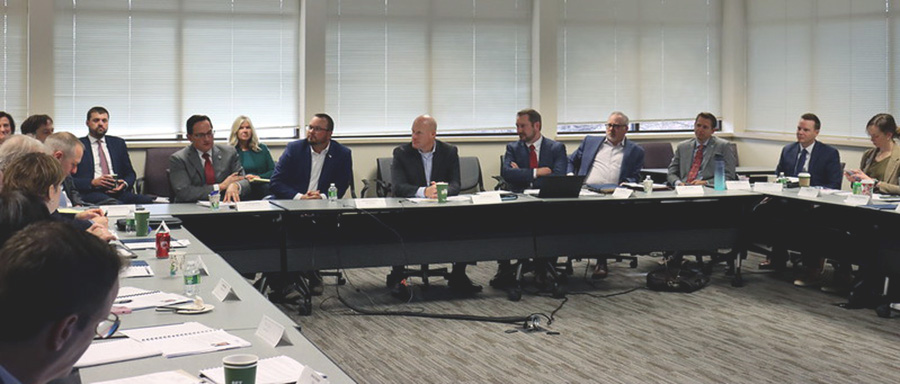Click here to view past issues
IN THIS ISSUE
EDUCATION EVENTS
Apr. 29, 2025
Critical Access Hospital (CAH) Conditions of Participation SeriesMay. 1, 2025
Beyond Basics of Case Mgt SeriesMay. 1, 2025
Critical Access Hospital (CAH) Conditions of Participation SeriesClick here to view quality event calendar
View more issues of The Valued Voice
Sign Up for WHA's Newsletter
Rep. Alex Dallman Joins WHA Public Policy Council, Discusses Challenges Facing Rural Health Care
“We need to keep building reimbursement up.”
Wisconsin Rep. Alex Dallman (R-Green Lake), a member of the powerful budget-writing Joint Finance Committee, joined WHA’s Public Policy Council on Nov. 13 to talk about recent election results, the Assembly’s support of hospitals in previous state budgets and challenges facing access to health care, particularly in rural communities.
“We need to be able to keep building reimbursement up, so our hospitals can remain solvent in our rural areas,” said Dallman, referencing the Assembly Republicans previous priorities for hospitals including funding the Disproportionate Share Hospital and Rural Critical Care programs. Wisconsin Rep. Alex Dallman met with WHA’s Public Policy Council on Nov. 13 to discuss the challenges facing access to health care in rural communities.Dallman discussed the closure of two clinics and a pharmacy in his district, along with closures of other clinics in districts around him. “My constituents are seeing the impact of the economy and how hospitals have been affected. People are worried about maintaining access to care in rural communities.”
Wisconsin Rep. Alex Dallman met with WHA’s Public Policy Council on Nov. 13 to discuss the challenges facing access to health care in rural communities.Dallman discussed the closure of two clinics and a pharmacy in his district, along with closures of other clinics in districts around him. “My constituents are seeing the impact of the economy and how hospitals have been affected. People are worried about maintaining access to care in rural communities.”
Council members described the challenges facing hospitals as they attempt to maintain access, while responding to both government and private insurance reimbursement rates that are not keeping pace with increased costs.
“You’re not going to see closures of entire hospitals in rural areas as drastic as you saw in Eau Claire and Chippewa Falls, but what you will see is death by a thousand cuts,” said Black River Memorial Hospital President and CEO Carl Selvick. “You’re going to see rural hospitals close key services, which don’t hit the headlines as much as an entire hospital closing. But when labor and delivery closes in a rural area, businesses are not going to grow and families are not going to come in.”
In the last eight years, 14 hospital labor and delivery units in Wisconsin have closed in both rural and urban communities with another closure in Elmbrook announced just last week.
Selvick described Black River’s continued commitment to labor and delivery services for their local community. “Our labor and delivery department loses $500,000 annually. We are motivated to keep it long-term, but some years that loss takes out our entire operating margin.”
“It’s been eye opening to see the tightness of your budgets, moving forward, and the decisions you are having to make to remain solvent in our rural communities,” said Dallman. “I’m really appreciative of what you’re all trying to do.”
After introducing Dallman, WHA President and CEO Eric Borgerding commented about the services that hospitals and health systems provide that address otherwise unmet needs in Wisconsin communities.
“In Chippewa Valley, those two hospitals closed. If you don’t live in those communities, it appeared troubling but all you see are two buildings closing. What most people don’t appreciate is when a hospital closes, the things they are supporting outside the walls of the hospital, that no one else will do, also go away,” said Borgerding.
Dallman realizes challenges facing every other business in Wisconsin, like workforce shortages and inflation, are also impacting hospitals. While Dallman recognizes concerns by those who want to lower the cost of health care, as businesses are facing increased expenses in many cost centers, he acknowledges that hospitals are just one component of health care costs.
“There are other aspects, not just hospitals,” said Dallman. “That’s where I feel the conversation gets lost. We need to have a more over-arching approach to decreasing costs.”
“What we saw happen in Eau Claire recently was eye-opening. Those struggles related to reimbursement are not isolated—we all deal with them,” said Chief External Affairs Officer Ryan Natzke of Marshfield Clinic.
Natzke applauded Dallman’s comprehension of health care public policy. “The issues we have are complex and tough to explain to people. We greatly value having legislators like you that understand these issues and are willing to be forward thinking about them.”
“Working with Eric and the rest of the WHA team has been awesome, they’ve been really responsive,” said Dallman. “I don’t ever really try to make a decision without, at first, getting all the facts and understanding what’s going on.”

